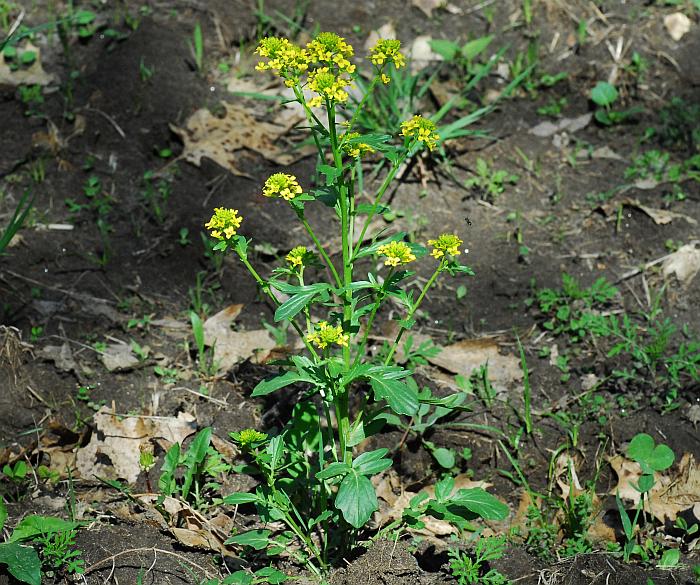Barbarea vulgaris W.T. Aiton
Yellow Rocket

Introduced
CC = *
CW = 3
MOC = 92
© SRTurner
Barbarea vulgaris W.T. AitonYellow Rocket | |
 |
Introduced CC = * CW = 3 MOC = 92 |
© SRTurner |
|
Family - Brassicaceae Habit - Taprooted biennial forb, or occasionally annual or short-lived perennial. Stems - Erect, to 1 m, sometimes branching, glabrous, herbaceous, ridged.
Leaves - Alternate, usually glabrous. Lower leaves lyrate, petiolate, to 20 cm long, pinnately divided or lobed. Lobes with coarse shallow teeth or entire. Upper leaves reduced, sessile, clasping, entire or irregularly pinnately lobed and toothed.
Inflorescence - Panicles with often compact racemose branches (rarely reduced to a solitary raceme), the lower branches rarely subtended by reduced leaves, the flowers bractless. Pedicels to 3 mm long, elongating in fruit to 6 mm long, 4-angled, glabrous.
Flowers - Sepals 4, erect, greenish-yellow, glabrous, 3-4 mm long, 1-1.5 mm broad, with lighter yellow margins. Petals 4, yellow, free, 5-9 mm long, 2-3 mm broad, truncate at apex, glabrous, tapering and lighter yellow to white at base. Stamens 6, erect. Longer 4 stamens with filaments to 4 mm long. Filaments glabrous, whitish yellow, with glands at base. Anthers yellow, 1.1-1.5 mm broad. Ovary (sub)terete, green, glabrous, 4 mm long. Styles 1.5-3.0 mm long, persistent. Stigma sub-biglobose.
Fruit - Siliques glabrous, erect to spreading, 1.5-3.0 cm long, slightly compressed, beaked. Beak to 3 mm long. Seeds 18-24 per fruit, the seeds 1.0-1.5 mm long, circular in outline, oblong in cross-section, somewhat flattened.
Flowering - April - June. Habitat - Open, disturbed areas, pastures, roadsides, railroads. Origin - Native to Eurasia. Lookalikes - B. verna. To a lesser extent, certain other members of the mustard family, e.g. Erysimum repandum. Other info. - This is a common plant across the entire state, as well as most of the continental U.S. It is easily recognized by the 4-petaled flowers in the Brassica pattern, and the highly characteristic stem leaves. These are typically lobed near the base, with the central lobe wedge-shaped and widest toward the tip, with a few blunt teeth at the tip. The in situ photo above is a good example.
Photographs taken at Danville Conservation Area, Montgomery County, MO., 4-17-04 (DETenaglia); also at Young Conservation Area, Jefferson County, MO, 4-24-2013 and 5-2-2013, Little Lost Creek Conservation Area, Warren County, MO, 5-12-2013, and Danville Conservation Area, Montgomery County, MO, 5-5-2018 (SRTurner). |